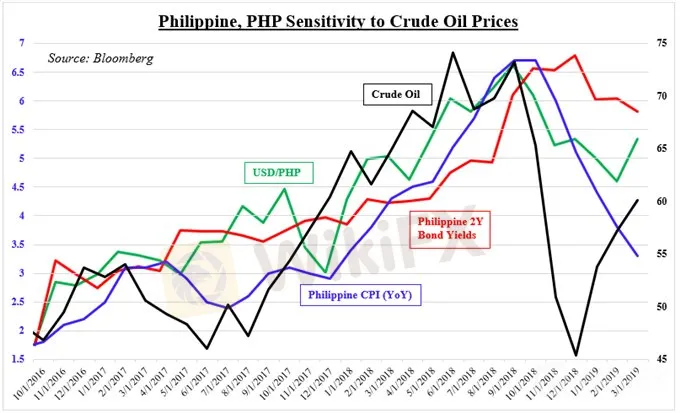简体中文
繁體中文
English
Pусский
日本語
ภาษาไทย
Tiếng Việt
Bahasa Indonesia
Español
हिन्दी
Filippiiniläinen
Français
Deutsch
Português
Türkçe
한국어
العربية
USD/PHP Eyes Reversal as Crude Oil Revives 2018 Peso Selloff Fears
Abstract:The Philippine Peso fell as crude oil prices rose on Iran supply disruption fears. USD/PHP broke key resistance. Higher petroleum prices may reignite 2018 Peso selloff if CPI climbs.
USD/PHP, Crude Oil, Iran Sanction Waivers Talking Points
Philippine Peso weakens as crude oil prices rise on Iran supply disruption concerns
Higher oil may fuel excess Philippine inflationary fears, reigniting 2018 PHP selloff
USD/PHP climbed above critical resistance, opening the door to further gains ahead
Trade all the major global economic data live as it populates in the economic calendar and follow the live coverage for key events listed in the DailyFX Webinars. Wed love to have you along.
The largest rise in crude oil prices since the beginning of April triggered a bout of risk aversion during the early phase of the week, and the Philippine Peso is under pressure. On Monday, US Secretary of State Mike Pompeo confirmed that the nation is planning on ending Iran sanction waivers on imports of the commodity, increasing supply disruption concerns.
This poses a risk for USD/PHP for a couple of reasons. On the chart below, Philippine CPI tends to have a close relationship to crude oil. The commodity is a key import for the Philippines and fears of higher prices could reinstate strong inflationary pressures which triggered a PHP selloff last year. CPI recently came off from its highest point since 2009 to a more manageable 3.3% y/y in March, within the central banks target.
Philippine Economy, Peso Sensitivity to Crude Oil

In fact, the cooldown in oil towards the end of 2018 helped stem depreciation in the Peso as inflation slowed and local front-end government bond yields aimed lower. The latter is a sign of decreasing risk of holding Philippine government debt. Since then, the commodity has rebounded and if it continues doing so, we might see Philippine CPI follow suit. This comes as the Philippine central bank ponders potential rate cuts.
Keep a close eye on US energy earnings this week as well as the nations trade negotiations with Japan. Weakening global growth forecasts might be reflected from companies such as Chevron in their outlook. Meanwhile, sentiment may be at risk due to diverging EU-US foreign policy given the aforementioned developments on Iranian sanction waivers which may increase the odds of a transatlantic trade war.
USD/PHP Technical Analysis
On the daily chart, USD/PHP rose 0.62% in its best single-day performance in over a month. This highlights the pairs sensitivity to unexpected surges in crude oil. Support held above 51.59 (May 2018 lows) as PHP broke above a descending trend line from the middle of March.
This opened the door to further Peso weakness given confirmation. Keep a close eye on what may be support-turned-resistance at 52.12. For more updates on the Philippine Peso and ASEAN currencies, you may follow me on Twitter here at @ddubrovskyFX.
USD/PHP Daily Chart

Disclaimer:
The views in this article only represent the author's personal views, and do not constitute investment advice on this platform. This platform does not guarantee the accuracy, completeness and timeliness of the information in the article, and will not be liable for any loss caused by the use of or reliance on the information in the article.
Read more

Quiet Before the Storm? Markets Poised for a Relaxed Week
For June 2024, Canada's CPI rose by 2.7% year-over-year, down from 2.9% previously. This decrease in core inflation is driven by a combination of slower economic growth and moderated wage growth, even with a strong labor market. The FOMC meeting minutes from July 2024 indicated that the Federal Reserve decided to maintain the federal funds rate within the target range of 5.25% to 5.50% and revealed a shift in the Fed's focus. The latest data on U.S. Initial Jobless Claims, for the week ending...

Fed Pressured: Will CPI Data Fuels Calls for Rate Cuts?
The U.S Producer Price Index (PPI) for June showed a month-over-month increase of 0.2%, which was slightly above market expectations of 0.1%. The Reserve Bank of New Zealand (RBNZ) recently kept its Official Cash Rate (OCR) unchanged at 5.50% during its last meeting on July 2024, which was consistent with market expectations. As of June 2024, the U.S. Consumer Price Index (CPI) showed a modest increase of 3.0% year-over-year, weaker than market expectation and previous reading of 3.1% and 3.3%..

Gold Surge to All-time High
he U.S. equity market continued its rally in yesterday's session, with the Dow Jones approaching its all-time high near the 41,000 mark. The Russell 2000 (US2000) small-cap index surged more than 10% since last Thursday, suggesting that strategists have been rotating their exposure to small-cap counters, which are more sensitive to interest rate changes.

Inflation Watch: CPI Data Unveiled Across Countries
In May, Canada's Consumer Price Index rose by 0.6%, surpassing both market forecasts of 0.6% and the previous figure of 0.5%. Statistics Canada attributes this increase primarily to higher food prices, especially for wheat-based products, which exerted notable inflationary pressures. The latest U.S. retail sales data for May 2024 shows a modest 0.1% month-over-month increase, a slight improvement following the previous month's 0.2% decline. This growth is driven by a gradual rise in sales...
WikiFX Broker
Latest News
BSP Shuts Down Uno Forex Over Serious AML Violations
ACY Securities Expands Global Footprint with South Africa Acquisition
Tokyo Police Arrest 4 for Unregistered FX Trading Scheme
Rupee gains against Euro
WikiEXPO Global Expert Interview: The Future of Financial Regulation and Compliance
DFSA Warns of Fake Loan Approval Scam Using Its Logo
Consob Sounds Alarm: WhatsApp & Telegram Users Vulnerable to Investment Scams
CySEC Revokes UFX Broker Licence as Reliantco Halts Global Operations
GCash, Government to Launch GBonds for Easy Investments
Bitcoin ETF Options Get Closer to Reality with CFTC Clarification
Currency Calculator


